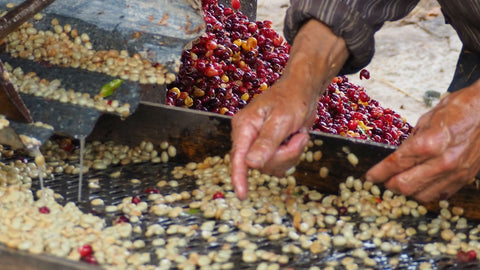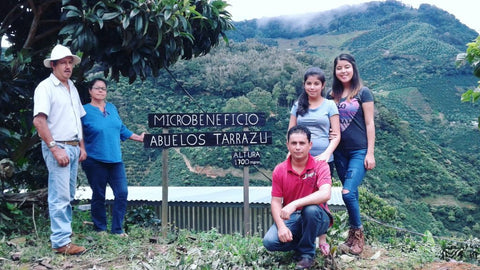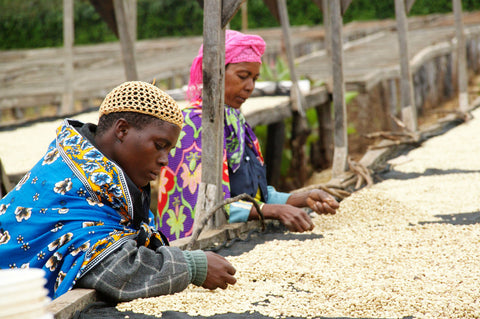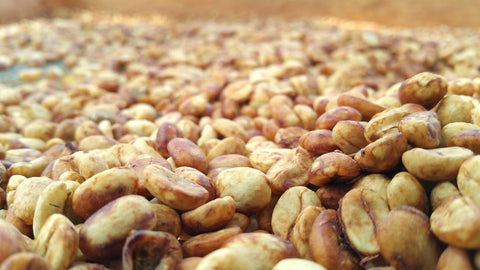Estate vs Microlot: What's the Difference?
What is the difference between an "estate" coffee versus a "microlot" coffee? Do those terms matter when you are buying coffee beans?
Traceability.
Not only in coffee, but in many food products, around the world, traceablity is not only becoming more desired, but also easier to execute. While most coffee is blended and exported in regional lots, in many circumstances, we can trace lots of coffees to single farms, or even a single acre.
Among the many benefits of traceability are that farmers are able to secure a living wage in exchange for the products they produce and consumers are able to have greater access and insight into the supply chain that produces their coffee.

She helped pick your coffee! Coffee production on the family-owned Edelweiss estate in Oldeani, Tanzania.
The most traceable lots are often referred to as 'microlots,' a term that may cause some confusion. Although this term is applied differently around the world, usually microlots are single farm coffees, selected for quality or species (i.e. Bourbon, Castillo,etc.)
There are many agricultural models utilized around the world--farms, estates, co-ops--each with differing levels of traceablity and highly dependent on local laws and customs. Some examples will help illuminate the complexity of subject.
Small Estate, Single Farmer.
We have several coffees at Trianon that can be traced to a single estate or farm, or single section of a farm. Our Honduras Lempira, for example, is grown by a farmer, Marvin Bonvilla and his family, who are part of a growing association through which their coffees might be blended and homogenized with other growers's coffees and sold as a regional export. But this year, the coffee from this farm was high enough quality to be isolated and exported as its own lot.

Coffee beans being inspected by hand during the washing process at Marvin Bonvilla’s farm in Honduras.
While this is clearly an estate coffee, it is not necessarily a microlot even though it comes from a single farm. Marvin may pull beans from all over his 60+ acre farm to make this coffee so special. So it was not sold as a microlot, but it is still highly traceable.
Isolated Lots & Special Processing Methods.
Another good example of traceablity is our Costa Rica Honey which is grown in the very famous Tarrazu region of Costa Rica. This is also from a family farm--of the Monge family, in the Santa Elena Estate--and not only is this coffee isolated from a single farm from within that estate, but it is further isolated by also going through the honey process. (In Costa Rica, most of the coffee is washed.)

The Monge family in Tarrazu, Costa Rica.
It is this isolation of a portion of a single farm's harvest which make this coffee a true "microlot."
Microlots & Estates.
One final illustration of these concepts comes from the two Tanzanian coffees currently in stock.
Our washed Tanzania (Edelweiss) comes from several Estates run by the Vohora family, including the Ascona, Helgoland, and Edelweiss Estates. It is a large geographic area with dozens of exported lots every year. So whereas the Honduras comes from a small estate, our Edelweiss lot comes from a larger estate-network. But still it is an estate coffee, and relatively traceable.

Coffee beans being dried on raised beds at Edelweiss Estate in Tanzania.
In Tanzania, many estates are vast in land area with many farms located within, a common agricultural structure in many of the well-established coffee growing regions of Africa and Indonesia.
Our Tanzania Honey is from the Finagro farm, within the aforementioned Ascona Estate. From this estate the Vohora family have exported a single lot of honey processed coffee. That gives this coffee the triple provenance of being single-estate, single-family, microlot coffee, specially selected and specially prepared. Traceability at it's finest.

Honey processed coffee beans from Finagro farm in Tanzania.
Takeaways.
These are just a few examples that hopefully help illuminate the terms we see on our coffee bags and bins. Practices vary considerably between regions of the world. Around the world of coffee, farm and estate sizes and structures are as varied as you can imagine them to be. But traceability always means the same thing.
We will continue to try to tell you exactly where your coffee comes from and bring you the farmers story. We think the coffee tastes better that way.
Want to try some of the coffees mentioned in this article? Browse our current selection of Small Estate & Microlot Coffees.


298 comments
CRYPTO SCAM RECOVERY SUCCESSFUL – A TESTIMONIAL OF LOST PASSWORD TO YOUR DIGITAL WALLET BACK.
My name is Robert Alfred, Am from Australia. I’m sharing my experience in the hope that it helps others who have been victims of crypto scams. A few months ago, I fell victim to a fraudulent crypto investment scheme linked to a broker company. I had invested heavily during a time when Bitcoin prices were rising, thinking it was a good opportunity. Unfortunately, I was scammed out of $120,000 AUD and the broker denied me access to my digital wallet and assets. It was a devastating experience that caused many sleepless nights. Crypto scams are increasingly common and often involve fake trading platforms, phishing attacks, and misleading investment opportunities. In my desperation, a friend from the crypto community recommended Capital Crypto Recovery Service, known for helping victims recover lost or stolen funds. After doing some research and reading multiple positive reviews, I reached out to Capital Crypto Recovery. I provided all the necessary information—wallet addresses, transaction history, and communication logs. Their expert team responded immediately and began investigating. Using advanced blockchain tracking techniques, they were able to trace the stolen Dogecoin, identify the scammer’s wallet, and coordinate with relevant authorities to freeze the funds before they could be moved. Incredibly, within 24 hours, Capital Crypto Recovery successfully recovered the majority of my stolen crypto assets. I was beyond relieved and truly grateful. Their professionalism, transparency, and constant communication throughout the process gave me hope during a very difficult time. If you’ve been a victim of a crypto scam, I highly recommend them with full confidence contacting:
📧 Email: Capitalcryptorecover@zohomail.com
📱 Telegram: Capitalcryptorecover Contact: Recoverycapitalfastservice.com
📞 Call/Text: +1 (336) 390-6684
🌐 Website: https://recovercapital.wixsite.com/capital-crypto-rec-1
I lost $45,000 to a scam, but JetWebHackers helped me recover my money in just 3 days. Their professionalism, quick action, and genuine concern gave me hope during a dark time. They also provided me with a blank ATM card, which I used to withdraw $10,000. Highly recommend their services!.. Contact them via WhatsApp: +1(763)357-2550 or email: jetwebhackers@gmail.com
GETTING BACK SCAMMED FUNDS FROM YOUR SCAMMERS.
GETTING BACK LOST, HACKED OR STOLEN CRYPTOCURRENCY // RESCUE TEAM RECOVERY COMPANY.
Recovery of Lost Crypto; Binary options scam, Investment scams, Loans scam Etc.
What happens after losing Bitcoin or a bank transfer to Fraudsters?
You can choose to accept the loss and give the con artists your hard-earned money, or you can choose the second choice.
As a result of your failure to stop the scammers, additional people will become victims, many of whom will most likely be your friends or relatives. You can contact bitcoin recovery professionals like Rescue Team Recovery Company at Email add (Rescueteamrecovery @ cyberservices. com) That will assist you in tracking and recovering your lost, scammed or hacked crypto currencies and band funds. The Rescue Team Recovery Company collaborates with law enforcement to help catch these con artists. You can proceed as long as you know the wallet address of the con artist or the receipts of the bank transactions.
I wish you success.
WhatsApp; +14706372676
Learn More; Eml: Rescueteamrecovery @ cyberservices . com
GETTING BACK SCAMMED FUNDS FROM YOUR SCAMMERS.
GETTING BACK LOST, HACKED OR STOLEN CRYPTOCURRENCY // RESCUE TEAM RECOVERY COMPANY.
Recovery of Lost Crypto; Binary options scam, Investment scams, Loans scam Etc.
What happens after losing Bitcoin or a bank transfer to Fraudsters?
You can choose to accept the loss and give the con artists your hard-earned money, or you can choose the second choice.
As a result of your failure to stop the scammers, additional people will become victims, many of whom will most likely be your friends or relatives. You can contact bitcoin recovery professionals like Rescue Team Recovery Company at Email add (Rescueteamrecovery @ cyberservices. com) That will assist you in tracking and recovering your lost, scammed or hacked crypto currencies and band funds. The Rescue Team Recovery Company collaborates with law enforcement to help catch these con artists. You can proceed as long as you know the wallet address of the con artist or the receipts of the bank transactions.
I wish you success.
WhatsApp; +14706372676
Learn More; Eml: Rescueteamrecovery @ cyberservices . com
GETTING BACK SCAMMED FUNDS FROM YOUR SCAMMERS.
GETTING BACK LOST, HACKED OR STOLEN CRYPTOCURRENCY // RESCUE TEAM RECOVERY COMPANY.
Recovery of Lost Crypto; Binary options scam, Investment scams, Loans scam Etc.
What happens after losing Bitcoin or a bank transfer to Fraudsters?
You can choose to accept the loss and give the con artists your hard-earned money, or you can choose the second choice.
As a result of your failure to stop the scammers, additional people will become victims, many of whom will most likely be your friends or relatives. You can contact bitcoin recovery professionals like Rescue Team Recovery Company at Email add (Rescueteamrecovery @ cyberservices. com) That will assist you in tracking and recovering your lost, scammed or hacked crypto currencies and band funds. The Rescue Team Recovery Company collaborates with law enforcement to help catch these con artists. You can proceed as long as you know the wallet address of the con artist or the receipts of the bank transactions.
I wish you success.
WhatsApp; +14706372676
Learn More; Eml: Rescueteamrecovery @ cyberservices . com